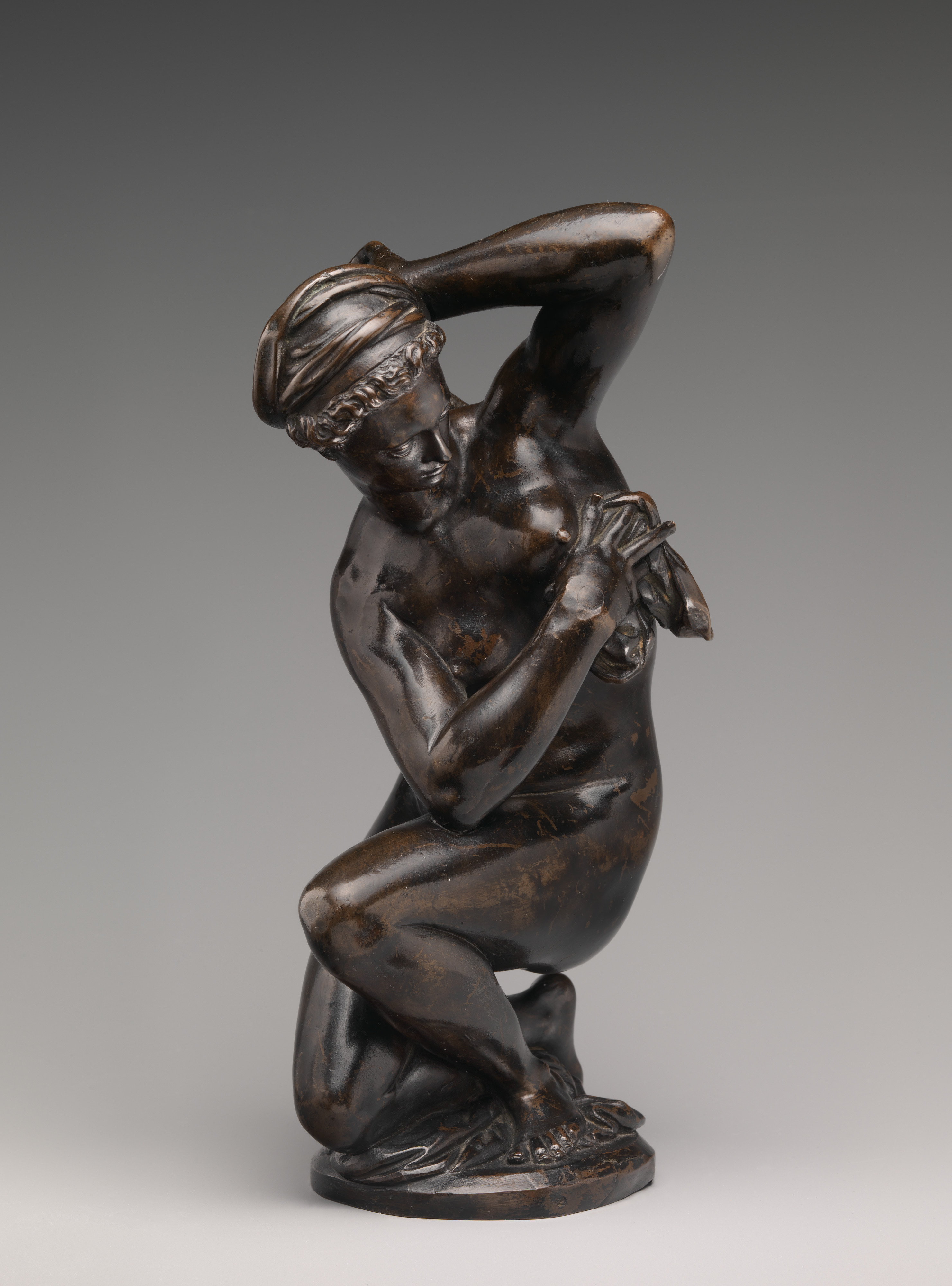Crouching Venus
After a model by Giambologna Netherlandish
Our statuette, which depicts a crouching woman drying herself after a bath, reproduces a celebrated invention by Giambologna (who was no doubt aware of the classical typology of the Doidalses Venus). Along with several other bronzes in the Mills bequest of 1924, it entered The Met with an attribution to the master himself. The composition is embodied in a bronze statuette long favored in the specialist literature on Giambologna and now in the Bargello.[1] This bronze is notable for the initials “I.B.F.” inscribed on the figure’s armband that might stand for “Iohannes Bologna Fecit,” as Dimitrios Zikos has proposed.[2] The Bargello bronze has been linked (without definitive documentation) to a statuette mentioned in the earliest inventory of Cardinal Ferdinando de’ Medici. Dated April 7, 1584, it records a female figure by “Gio. Bologna . . . with her knee on the ground, a hand at her head, and the other [hand] on her left breast with a cloth under her feet,” and notes its recent addition to the prelate’s garderobe in the Villa Medici, Rome.[3] Another “bronze statuette of a kneeling woman” that may refer to the same model is listed in the estate inventory of Lorenzo Salviati in 1609, notably as by Giambologna, with a height of “braccia 0/3 [19.3 cm].”[4]
Evidence such as the signature on the Bargello cast and the composition’s presence in a prestigious Roman collection attests to the popularity of this Giambolognesque pensiero, appreciated for its “classical” theme and pleasing formal design. The Mills Venus belongs to the considerable corpus of bronzes derived from Giambologna’s invention and produced well into the nineteenth century. Curiously, our statuette is missing the left pinkie finger, an anomaly shared with versions of the same composition in the Huntington (fig. 120a); the Holburne Museum, Bath; and the Robert H. Smith collection. With regard to the Smith bronze, it is thought that the break occurred in the original wax model.[5] The Huntington statuette has been considered by some to be an autograph work by Giambologna directly related to the Bargello bronze.[6] Both the Smith and Holburne casts are attributed to Antonio Susini, longtime collaborator of Giambologna, after the original model by the Flemish master.[7] This stemma codicum could point to a specific series directly cast from an authoritative archetype—perhaps autograph—missing the fifth digit (presumably raised in a charming gesture), though it has not been possible to identify its provenance.
The Huntington, Holburne, and Smith bronzes have a thick, circular base integrally cast with the figure. The same type of base is found in the Bargello bronze and other signed works by Giambologna like the Venus Urania (p. 00, fig. 126a). In this respect, our Venus is an outlier: its thinner, more roughly modeled base contrasts poorly with the complex play of drapery at the feet, forming instead a less precise arrangement and an altogether inadequate functionality. This combined with the merely passing quality of cold work (e.g., in the left hand awkwardly tightening the turban at the nape of the neck, in the drapery along the back) situates the Mills Venus “downstream” chronologically in the sequence of replicas discussed here. In terms of attribution, these factors also place it outside of Giambologna’s immediate circle. On the other hand, in the supple fleshiness of the bronze and the use of wax-to-wax joins, the casting is faithful to that of the Bargello and Huntington statuettes (whose technical characteristics were brought to light by Shelley Sturman).[8] The presence of numerous cylindrical plugs of various sizes in our Venus—noted by Richard Stone—likely pushes the production time frame into the seventeenth century.[9]
-TM
Footnotes
(For key to shortened references see bibliography in Allen, Italian Renaissance and Baroque Bronzes in The Metropolitan Museum of Art. NY: The Metropolitan Museum of Art, 2022.)
1. Bargello, 62 B; Desjardins 1883, pp. 134–35.
2. Paolozzi Strozzi and Zikos 2006, pp. 199–200, cat. 18.
3. “da m. Gio. Bologna . . . che sta con un Ginocchio in terra una mano alla testa e l’altra alla poppa manca con un panno sotto piè.” Cited in ibid., p. 199.
4. “femminina di bronzo che sta ginocchioni.” Cited in ibid.
5. Radcliffe and Penny 2004, p. 190.
6. Wark 1959, p. 63.
7. Manfred Leithe-Jasper and Anthony Radcliffe in C. Avery et al. 1978, p. 102, cat. 20; Radcliffe in C. Avery and Radcliffe 1978, p. 75, cat. 20.
8. Sturman 2001, pp. 126–27. Richard Stone has suggested that the use of tapered, driven plugs, instead of the more typical threaded ones, in our Venus indicates that the cast dates to the sixteenth century. R. Stone/TR, February 23, 2011.
Due to rights restrictions, this image cannot be enlarged, viewed at full screen, or downloaded.
This artwork is meant to be viewed from right to left. Scroll left to view more.



